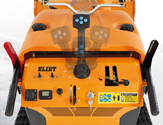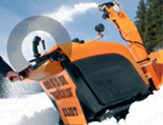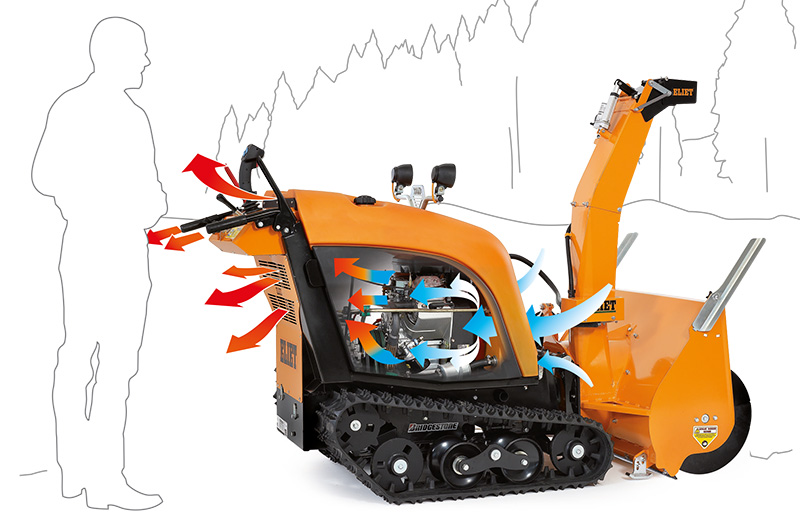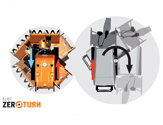Deze website maakt gebruik van cookies om uw gebruikservaring te verbeteren. Door verder te surfen, stemt u in met onze Cookie en Privacy Policy. Accepteer
Snowbob 9018T

Eliet all-in-one™ joystick
Voor het eerst op de markt introduceert ELIET de Multi function Joystick bediening. Dit is een centraal geplaatste Joystick die 5 essentiële functies voor de sturing van een sneeuwruimer centraliseren:
1. Bepalen van rijrichting en rijsnelheid
2. Sturen van de sneeuwruimer
3. Verdraaien van de blaaspijp (links – rechts)
4. Bedienen van de richtkleppen (naar boven – naar onder)
5. Oplichten van de freeskop
1. RIJDSNELHEID BEPALEN
Dankzij de dubbele hydrostaatpomp kan de bediener de rijdsnelheid van beide rupsen onafhankelijk van elkaar proportioneel sturen zowel in voorwaartse als achterwaartse rijdrichting, door eenvoudigweg de All-In-One Joystick traploos naar voor of naar achter te bewegen.
2. RIJDRICHTING BEPALEN
Beweegt men de joystick zijdelings, dan wordt de rupsaandrijving aan elke zijde verschillend geregeld.
In praktijk komt het er op neer dat een joystickbeweging naar links, de snelheid op de rechter rups verhoogt, waardoor de machine naar links weg draait. Bij een joystickbeweging naar rechts draait de machine naar rechts af.

Eliet cruise control™
De Snowbob 9018T is heel gebruiksvriendelijk en kan ook naar de specifieke wens van de operator worden afgesteld. Om de sneeuwruimer zijn rijsnelheid te geven, beweegt men de centrale joystick en houdt deze in een bepaalde stand aan. Sommige bedieners verkiezen om de snelheidsinstelling te blokkeren als men de hand van de centrale joystick los laat. De Snowbob is hier standaard op voorzien en mits een kleine afstelling kan een dergelijke cruise controle functie worden geactiveerd.

Eliet hot spot™
Als de temperatuur diep onder het nulpunt is gedaald en er staat een ijzige wind die de gevoelstemperatuur nog een aantal graden laat dalen, dan komt één van de belangrijke meerwaarden van de Snowbob 9018T ten volle tot uiting. De Snowbob is namelijk voorzien van een bediener-verwarmingssysteem. De motor van de machine is volledig ingebouwd in de behuizing. De koellucht om de motor en transmissie op optimale bedrijfstemperatuur te houden, wordt in de machine zo omgeleid dat de opgewarmde lucht in de richting van de operator wordt geblazen. Via een groot rooster aan de achterzijde van de machine stroomt warme lucht op het onderlichaam van de operator. Een smal rooster boven het instrumentenbord geleidt de warme lucht naar de handen aan de bedieningselementen. De handgrepen van de machine worden tevens door de warme lucht opgewarmd.
Professionele gebruikers die dagelijks een aantal uur met de machine in de weer zijn, weten deze eigenschap ten zeerste te appreciëren.

Eliet zero turn™
Revolutionair vernieuwend op de markt is dat de Snowbob in tegenstelling tot andere sneeuwruimers niet gestuurd wordt door de aandrijving op één van de rupsen te ontkoppelen of door één van de rupsen te remmen maar wel door actief de rijsnelheid op elke rups te sturen. Door de ene rups sneller te laten draaien dan de andere kan men een lange bocht nemen, door extreem de ene rups voorwaarts en de andere rups achterwaarts te laten draaien kan men de machine zelfs ter plaatse om zijn as laten draaien. Opnieuw is de bediening bij de Snowbob heel eenvoudig. Door de centrale joystick naar links of naar rechts te bewegen laat men de machine desgevallend draaien. Hoe verder men de pook in een richting beweegt hoe meer de draaibeweging van de machine wordt versterkt.
Deze zogenaamde Zero-Turn biedt een aantal belangrijke voordelen:
1. Bij het draaien blijven beide rupsen in beweging waardoor men betere grip behoudt op de sneeuw en waardoor de bediener betere controle behoudt over zijn machine.
2. In tegenstelling tot andere sneeuwruimers ligt het draaipunt niet op de stilstaande rups maar rond een virtuele aslijn van de machine. Hierdoor moet de Snowbob in dit draaipunt niet afrekenen met de grote weerstand van het contactvlak van de rups waardoor we het doorslippen van de rups vermijden.
3. Het inzetten van een draaibeweging is voor de Snowbob een continue vloeiende beweging. Andere sneeuwruimers komen kortstondig tot stilstand waardoor de inertie van het gewicht de rupsen bij aanzet sneller laten doorslippen.
4. Als men bij het ruimen in diepe sneeuw in een situatie terecht komt waar de machine zich dreigt in te graven, heeft de operator bij de Snowbob met zijn actieve aandrijving op beide rupsen veel meer kansen om zich uit een dergelijke situatie autonoom te bevrijden.
-1.jpg)